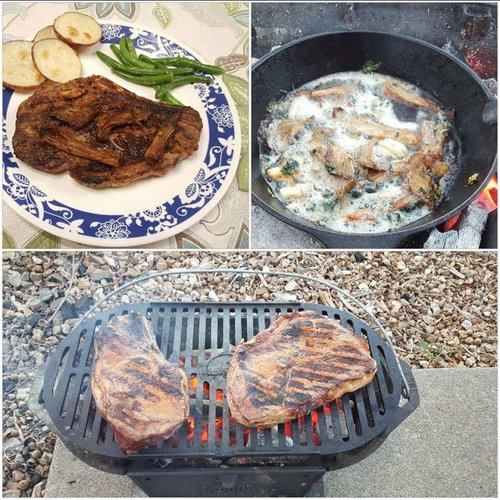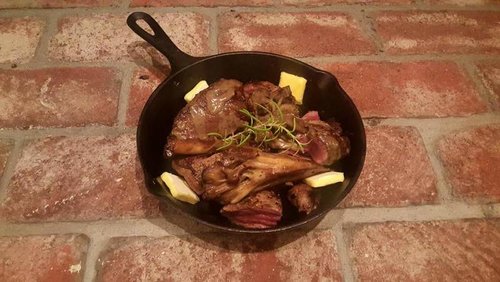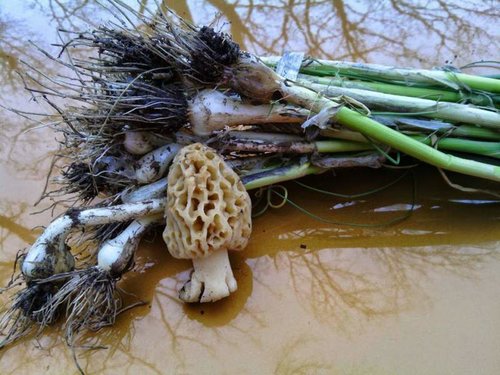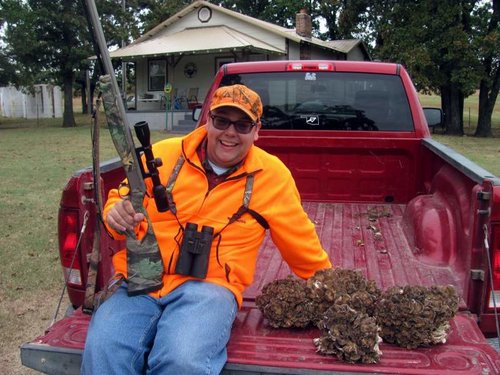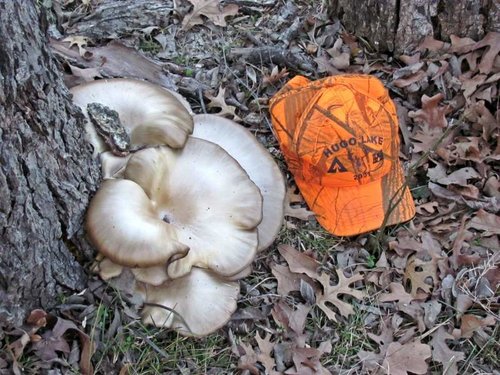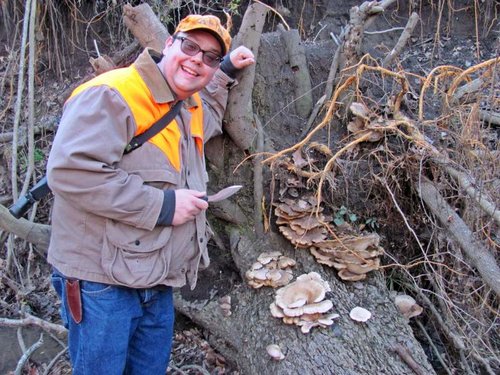Sainte_Terrer
New member
- Joined
- Jun 19, 2016
- Messages
- 43
This is an excerpt from my blog that I thought y'all would appreciate. I'm recovering from wisdom tooth extraction right now, otherwise I'd be out gathering more of these delicious mushrooms.
******
The ills of social media are far too numerous to list. We over-share, under-communicate, and generally forget that the nodes that we interact with are in fact humans. I’m as guilty as the next person when it comes to being fiercely opinionated and I have to watch myself that I don’t needlessly offend those that I maintain e-relationships with. Yet, despite the fact that social media is the great time-waster of our age, there are substantial benefits to having an account.
Over the past year I have increasingly dedicated my spare time to deepening my knowledge regarding the Fungi Kingdom. Naturally, this has led me to join numerous Facebook groups focused on the identification, gathering, and in many cases eating of fungi. The states that I frequent all have their respective forums where mycophiles share, discuss, and argue about their finds. These include: The Kaw Valley Mycological Society, The Missouri Mycological Society, and Oklahoma Mushroom Enthusiasts. There is even an Oklahoma group especially dedicated to morels! I find myself visiting these group weekly. This provides the opportunity to not only grow as a budding amateur mycologist, but also to get a feel for the emerging of choice edibles. When I can’t get out to see what fungal personalities are thriving in my local woods, I can always consult one of these resources and instantly obtain a fair survey of what exactly is thriving in the current season. It is a wonderful tool. In fact, properly approached, this trove of information could probably give a very reliable picture of the seasonality of select mushrooms throughout the region.
Last week I spent entirely too much time poring over the Missouri Mycological Society’s page. Glued to the screen, I note that prodigious amounts of stunning golden chanterelles* were being harvested after a recent rainfall—the very same storm system that had drenched my own parcel of God’s green earth. Inspired, I eagerly asked for information about the habitats, tendencies and peculiarities of these beautiful, trumpet-shaped fungi. As it turns out, hillsides near bodies of water in forested areas were being productive. The very same day I took this bit of intelligence and drove to the area that I had decided was most promising.
The generous rains meant that the heat index had soared throughout the day, reaching 113 F at its peak. Even at 7 P.M., the temperature exceeded 93 F and the humidity in the bottomland was absolutely unbelievable. The dead still of the depression was only disrupted by the near-constant buzzing of hundreds of pairs of wings: a veritable Luftwaffe of mosquitoes. Knowing this, I quickly made a series of deadly-serious, half-breathing ablutions with a can of Deep Woods OFF! before venturing from my truck. Little use! Dissuasion was beyond the grasping of the cloud of Culex as I constantly waved my walking staff to ward off those who dove too close to my unshielded ears. On the upside, the constant harassment forced me not to linger in the widespread patches of hip-high poison ivy. Unfortunately, the same constant motion denies the forager the opportunity to carefully scrutinize the ground (for chanterelles) and the trees (for Chicken of the Woods). Thus, I beat feet to the creek crossing where I had a week before found a cluster of dried Wood Ear. The gambit paid handsomely; the Wood Ear were regenerated by the rains and I was able to cut a double-handful from a downed tree just off the creek bed.
Looking up the ridgeline I noticed a very large tree that had been downed by heavy winds. I cut a vector for this tree (ideal mushroom habitat) when I caught movement in the canopy above. Just 40 yards away, a mature gray squirrel bounded from branch-to-branch. By keeping the larger trees between us I was able to close the distance to 20 yards and just as the squirrel paused on an adjacent limb I brought my .22 LR target pistol to bear. One hasty shot sent the squirrel tumbling through the layers of vegetation and I knew that wild game would be in the larder this week. After recovering the squirrel I cut westward across the ridgeline and practically stumbled on a cluster of shining goldenrod fungi. Could it be? I had in fact found my first chanterelles! The find was bittersweet. The only two specimens large enough to pick were plainly riddled with insects. The remainder were too small and I feared that the forecasted days of dry heat meant that they would not have the opportunity to mature. Nonetheless, I had accomplished my mission.
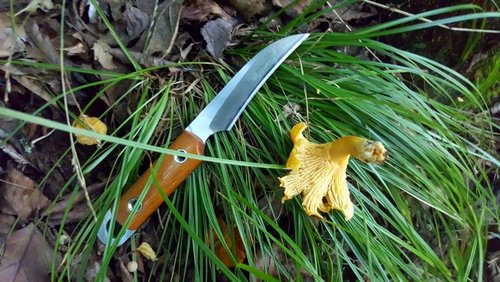
The trudge back to the truck was less rewarding. The heat and humidity had really begun to take their toll. I swatted mosquitoes and cleared spiderwebs the entire way back. Upon arriving at the parking lot I promptly dropped by pack and began guzzling a giant Nalgene bottle of water. I was on the verge of heat exhaustion, having walked at least a half-mile through unforgiving country in the lamentable conditions of July. I felt the tickle of spiderwebs on the nape of my neck and itched the bites on my arms. Laying out my trophies for examination, I also noted that I had collected a very large Brown Recluse on my backpack. In my stupor, I wandered round the gravel parking lot, sipping water. Having meandered about 15 ft from my truck I noticed something interesting in the grass perimeter and parted the ground-cover to reveal not one but three more chanterelles! I could not believe it. Prophetically, I had written about finding morels in bar ditches back in 2015. No doubt this was a testament to the unpredictability of fungi! I also took it as a blessing.
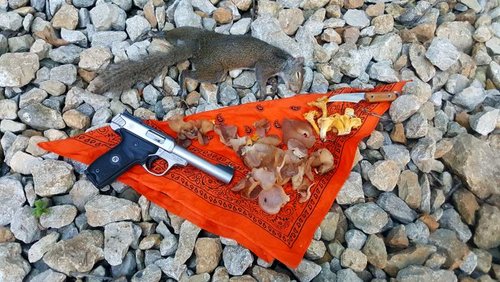
The next day I was determined to cook a meal befitting of both the squirrel and chanterelles. My browsing stopped when I reached a recipe for Swabian “Pockets” (Schwabishe Maultaschen) in Mimi Sheraton’s The German Cookbook. These pockets were really little dumplings filled with minced meat, grated onion, spinach, eggs, and breadcrumbs—and flavored with classic German spices like nutmeg and allspice. I’ll be honest, I had never made this sort of dumplings before. I broke out the KitchenAid and proceeded to coat our kitchen with a fine layer of all-purpose flour. The dough actually did work though—I cut out 3” scalloped rounds and stuffed them with a mixture of minced squirrel meat (that had been parboiled in chicken stock), spinach, grated onion, rehydrated wild oyster mushrooms* and the fresh chanterelles. I then cooked these dumplings in the reserved stock and mushroom broth with juniper berries, black pepper, and more allspice. Despite my complete absence of dumpling-making skills, the result was sublime. I’d love to share the recipe with you but the fact is that I don’t have one. I eyeball a lot of my ingredients while cooking and this dish was no different. If you want to approximate it, pick up a copy of The German Cookbook.
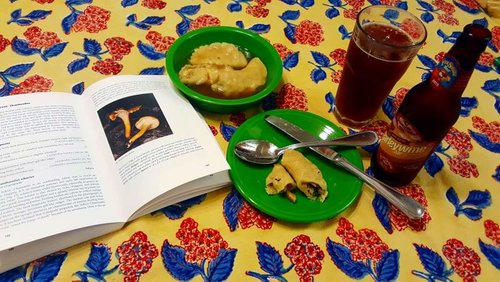
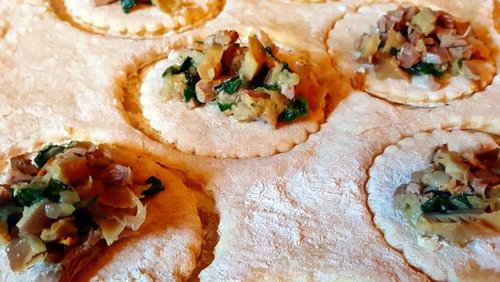
*The chanterelles that I found belong to the Cantharellus cibarius clade, but this nomenclature is no longer accepted for all of the golden chanterelles in the United States. Rather, Cantharellus cibarius is likely only found in Europe and the U.S. has several closely related species.
*The oyster mushrooms were Pleurotus ostreatus or the Fall Oyster.
******
The ills of social media are far too numerous to list. We over-share, under-communicate, and generally forget that the nodes that we interact with are in fact humans. I’m as guilty as the next person when it comes to being fiercely opinionated and I have to watch myself that I don’t needlessly offend those that I maintain e-relationships with. Yet, despite the fact that social media is the great time-waster of our age, there are substantial benefits to having an account.
Over the past year I have increasingly dedicated my spare time to deepening my knowledge regarding the Fungi Kingdom. Naturally, this has led me to join numerous Facebook groups focused on the identification, gathering, and in many cases eating of fungi. The states that I frequent all have their respective forums where mycophiles share, discuss, and argue about their finds. These include: The Kaw Valley Mycological Society, The Missouri Mycological Society, and Oklahoma Mushroom Enthusiasts. There is even an Oklahoma group especially dedicated to morels! I find myself visiting these group weekly. This provides the opportunity to not only grow as a budding amateur mycologist, but also to get a feel for the emerging of choice edibles. When I can’t get out to see what fungal personalities are thriving in my local woods, I can always consult one of these resources and instantly obtain a fair survey of what exactly is thriving in the current season. It is a wonderful tool. In fact, properly approached, this trove of information could probably give a very reliable picture of the seasonality of select mushrooms throughout the region.
Last week I spent entirely too much time poring over the Missouri Mycological Society’s page. Glued to the screen, I note that prodigious amounts of stunning golden chanterelles* were being harvested after a recent rainfall—the very same storm system that had drenched my own parcel of God’s green earth. Inspired, I eagerly asked for information about the habitats, tendencies and peculiarities of these beautiful, trumpet-shaped fungi. As it turns out, hillsides near bodies of water in forested areas were being productive. The very same day I took this bit of intelligence and drove to the area that I had decided was most promising.
The generous rains meant that the heat index had soared throughout the day, reaching 113 F at its peak. Even at 7 P.M., the temperature exceeded 93 F and the humidity in the bottomland was absolutely unbelievable. The dead still of the depression was only disrupted by the near-constant buzzing of hundreds of pairs of wings: a veritable Luftwaffe of mosquitoes. Knowing this, I quickly made a series of deadly-serious, half-breathing ablutions with a can of Deep Woods OFF! before venturing from my truck. Little use! Dissuasion was beyond the grasping of the cloud of Culex as I constantly waved my walking staff to ward off those who dove too close to my unshielded ears. On the upside, the constant harassment forced me not to linger in the widespread patches of hip-high poison ivy. Unfortunately, the same constant motion denies the forager the opportunity to carefully scrutinize the ground (for chanterelles) and the trees (for Chicken of the Woods). Thus, I beat feet to the creek crossing where I had a week before found a cluster of dried Wood Ear. The gambit paid handsomely; the Wood Ear were regenerated by the rains and I was able to cut a double-handful from a downed tree just off the creek bed.
Looking up the ridgeline I noticed a very large tree that had been downed by heavy winds. I cut a vector for this tree (ideal mushroom habitat) when I caught movement in the canopy above. Just 40 yards away, a mature gray squirrel bounded from branch-to-branch. By keeping the larger trees between us I was able to close the distance to 20 yards and just as the squirrel paused on an adjacent limb I brought my .22 LR target pistol to bear. One hasty shot sent the squirrel tumbling through the layers of vegetation and I knew that wild game would be in the larder this week. After recovering the squirrel I cut westward across the ridgeline and practically stumbled on a cluster of shining goldenrod fungi. Could it be? I had in fact found my first chanterelles! The find was bittersweet. The only two specimens large enough to pick were plainly riddled with insects. The remainder were too small and I feared that the forecasted days of dry heat meant that they would not have the opportunity to mature. Nonetheless, I had accomplished my mission.

The trudge back to the truck was less rewarding. The heat and humidity had really begun to take their toll. I swatted mosquitoes and cleared spiderwebs the entire way back. Upon arriving at the parking lot I promptly dropped by pack and began guzzling a giant Nalgene bottle of water. I was on the verge of heat exhaustion, having walked at least a half-mile through unforgiving country in the lamentable conditions of July. I felt the tickle of spiderwebs on the nape of my neck and itched the bites on my arms. Laying out my trophies for examination, I also noted that I had collected a very large Brown Recluse on my backpack. In my stupor, I wandered round the gravel parking lot, sipping water. Having meandered about 15 ft from my truck I noticed something interesting in the grass perimeter and parted the ground-cover to reveal not one but three more chanterelles! I could not believe it. Prophetically, I had written about finding morels in bar ditches back in 2015. No doubt this was a testament to the unpredictability of fungi! I also took it as a blessing.

The next day I was determined to cook a meal befitting of both the squirrel and chanterelles. My browsing stopped when I reached a recipe for Swabian “Pockets” (Schwabishe Maultaschen) in Mimi Sheraton’s The German Cookbook. These pockets were really little dumplings filled with minced meat, grated onion, spinach, eggs, and breadcrumbs—and flavored with classic German spices like nutmeg and allspice. I’ll be honest, I had never made this sort of dumplings before. I broke out the KitchenAid and proceeded to coat our kitchen with a fine layer of all-purpose flour. The dough actually did work though—I cut out 3” scalloped rounds and stuffed them with a mixture of minced squirrel meat (that had been parboiled in chicken stock), spinach, grated onion, rehydrated wild oyster mushrooms* and the fresh chanterelles. I then cooked these dumplings in the reserved stock and mushroom broth with juniper berries, black pepper, and more allspice. Despite my complete absence of dumpling-making skills, the result was sublime. I’d love to share the recipe with you but the fact is that I don’t have one. I eyeball a lot of my ingredients while cooking and this dish was no different. If you want to approximate it, pick up a copy of The German Cookbook.


*The chanterelles that I found belong to the Cantharellus cibarius clade, but this nomenclature is no longer accepted for all of the golden chanterelles in the United States. Rather, Cantharellus cibarius is likely only found in Europe and the U.S. has several closely related species.
*The oyster mushrooms were Pleurotus ostreatus or the Fall Oyster.
Last edited:




